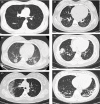Radiological findings and clinical characteristics of pregnant women with COVID-19 pneumonia
- PMID: 32270479
- PMCID: PMC9087759
- DOI: 10.1002/ijgo.13165
Radiological findings and clinical characteristics of pregnant women with COVID-19 pneumonia
Erratum in
-
Corrigendum.Int J Gynaecol Obstet. 2021 Mar;152(3):465. doi: 10.1002/ijgo.13521. Epub 2021 Jan 9. Int J Gynaecol Obstet. 2021. PMID: 33616922 Free PMC article. No abstract available.
Abstract
Objective: To study chest CT images and clinical characteristics of COVID-19 pneumonia in pregnant patients to examine any correlation.
Methods: Between December 31, 2019 and March 7, 2020, 23 hospitalized pregnant patients with confirmed COVID-19 were enrolled in the study. Clinical presentations were collected retrospectively from records, including laboratory testing, chest CT imaging, and symptoms. Descriptive analysis and correlation of patients' clinical and CT characteristics were performed. Laboratory results from time of first admission and CT absorption (defined as reduction in lesion area, decrease in density, and absorption of some solid components) were compared between symptomatic and asymptomatic patients.
Results: Fifteen (65.2%) patients were asymptomatic with patchy ground-glass opacity in a single lung lobe. Eight (34.8%) patients were symptomatic with multiple patchy ground-glass shadows, consolidation, and fibrous stripes. Differences in lymphocyte percentage and neutrophil granulocyte rate between first admission and CT absorption were significant (P<0.001). Median absorption time was shorter in the asymptomatic group compared with the symptomatic group (5 vs 10 days; P<0.001). Median hospitalization time between asymptomatic and symptomatic patients was 14 vs 25.5 days; P>0.001. Median absorption time and length of hospitalization for all patients was 6 days (IQR 5-8) and 17 days (IQR 13-25), respectively.
Conclusion: Radiological findings and clinical characteristics in pregnant women with COVID-19 were similar to those of non-pregnant women with COVID-19. Median absorption time and length of hospitalization in asymptomatic patients were significantly shorter than in symptomatic patients. Lymphocyte percentage and neutrophil granulocyte rate may be used as laboratory indicators of CT absorption.
Keywords: COVID-19; CT scan; Pneumonia; Pregnancy.
© 2020 International Federation of Gynecology and Obstetrics.
Conflict of interest statement
The authors have no conflicts of interest.
Figures

Similar articles
-
Clinical and CT imaging features of the COVID-19 pneumonia: Focus on pregnant women and children.J Infect. 2020 May;80(5):e7-e13. doi: 10.1016/j.jinf.2020.03.007. Epub 2020 Mar 21. J Infect. 2020. PMID: 32171865 Free PMC article.
-
CT characteristics and diagnostic value of COVID-19 in pregnancy.PLoS One. 2020 Jul 2;15(7):e0235134. doi: 10.1371/journal.pone.0235134. eCollection 2020. PLoS One. 2020. PMID: 32614854 Free PMC article.
-
Imaging and clinical features of patients with 2019 novel coronavirus SARS-CoV-2.Eur J Nucl Med Mol Imaging. 2020 May;47(5):1275-1280. doi: 10.1007/s00259-020-04735-9. Epub 2020 Feb 28. Eur J Nucl Med Mol Imaging. 2020. PMID: 32107577 Free PMC article.
-
Clinical, laboratory and radiological characteristics and outcomes of novel coronavirus (SARS-CoV-2) infection in humans: A systematic review and series of meta-analyses.PLoS One. 2020 Sep 17;15(9):e0239235. doi: 10.1371/journal.pone.0239235. eCollection 2020. PLoS One. 2020. PMID: 32941548 Free PMC article.
-
Chest computed tomography findings in hospitalized COVID-19 patients: a systematic review and meta-analysis.Infez Med. 2020 Sep 1;28(3):295-301. Infez Med. 2020. PMID: 32920564
Cited by
-
Clinical outcomes of maternal and neonate with COVID-19 infection - Multicenter study in Saudi Arabia.J Infect Public Health. 2021 Jun;14(6):702-708. doi: 10.1016/j.jiph.2021.03.013. Epub 2021 Apr 20. J Infect Public Health. 2021. PMID: 34020209 Free PMC article.
-
Maternal clinical characteristics and perinatal outcomes among pregnant women with coronavirus disease 2019. A systematic review.Travel Med Infect Dis. 2021 Jan-Feb;39:101919. doi: 10.1016/j.tmaid.2020.101919. Epub 2020 Nov 19. Travel Med Infect Dis. 2021. PMID: 33220455 Free PMC article.
-
Manifestations of COVID-19 in pregnant women with focus on gastrointestinal symptoms: a systematic review.Gastroenterol Hepatol Bed Bench. 2020 Fall;13(4):305-312. Gastroenterol Hepatol Bed Bench. 2020. PMID: 33244372 Free PMC article. Review.
-
Evaluating antibody response pattern in asymptomatic virus infected pregnant females: Human well-being study.J King Saud Univ Sci. 2021 Jan;33(1):101255. doi: 10.1016/j.jksus.2020.101255. Epub 2020 Dec 2. J King Saud Univ Sci. 2021. PMID: 33288976 Free PMC article.
-
Epidemiologic characteristics, clinical management, and public health implications of Coronavirus Disease 2019 (COVID-19) in pregnancy: A Systematic Review and Meta-analysis.Nepal J Epidemiol. 2021 Dec 31;11(4):1103-1125. doi: 10.3126/nje.v11i4.41911. eCollection 2021 Dec. Nepal J Epidemiol. 2021. PMID: 35070470 Free PMC article.

